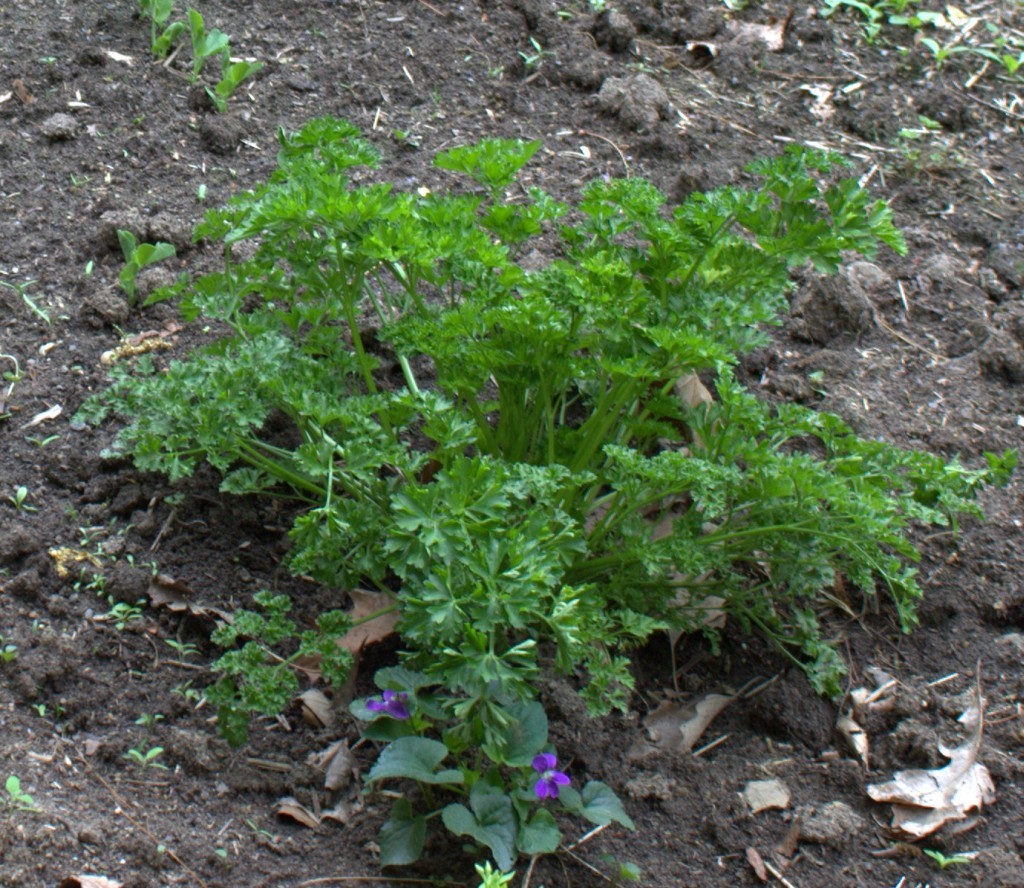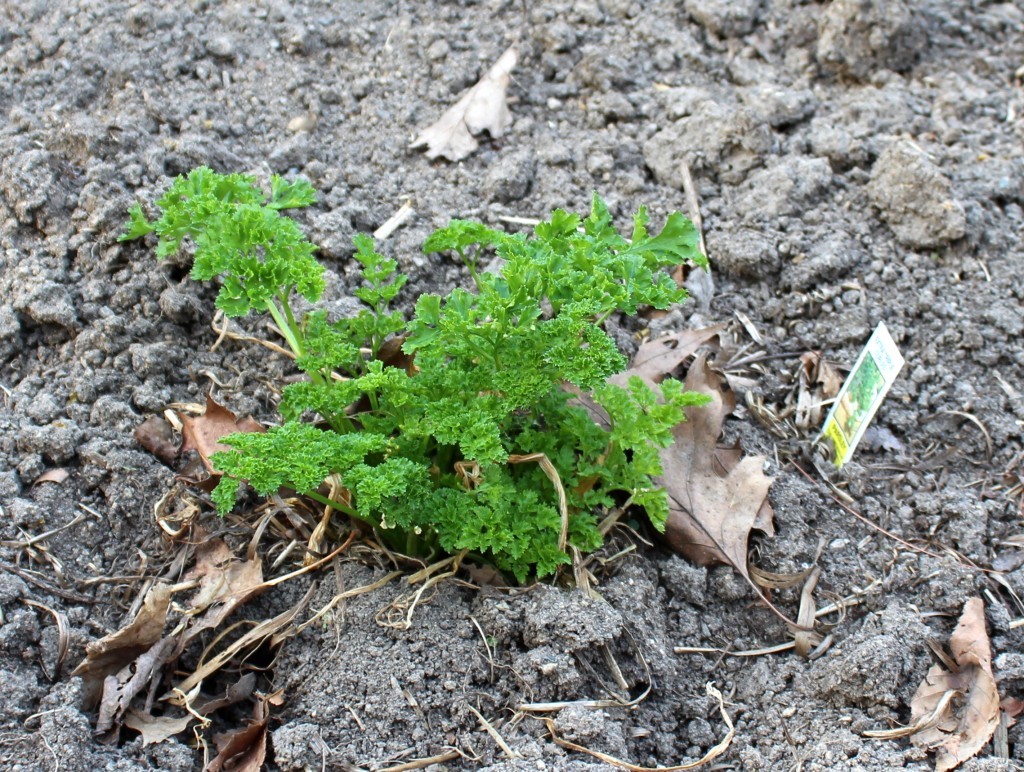Herb: Parsley
Parsley, Petroselinum crispum, is a culinary herb used to flavor vegetables, soups and stews.
Parsley Characteristics
- biennial
- reaches 6 to 20 inches tall
- foliage is divided, leaflets very curly
- flower stalk rises in second year
- tiny white to yellow flowers in compound umbels
- cultivated in gardens for culinary use
Parsley Uses
- culinary
- gardening
Growing Parsley
Growing conditions: Parsley can be grown in full sun, but prefers a little afternoon shade. Parsley is a biennial and on its second year will send up a flower stalk in the early spring. Cut the flower stalk before it rises too far for seed production and you can enjoy a second year's harvest of last year's plant.
Light: sun
Height: 18 inches
Spacing: 12 inches
Planting comments: Seeds are slow to germinate. Soak seed in warm water before planting. Seeds can be broadcast or planted in drills one foot apart and barely a half-inch deep. Sow seeds in spring for a summer harvest and sow parsley in summer to have small plants to bring inside for winter harvesting. When planting parsley in containers use a tall pot to accommodate its long taproot.


Where to Buy Parsley
Parsley is available as seeds or plants. Depending on the time of year you may be able to find a plant at your nearby garden center. In case they’re are not available locally, here are some places that offer herb seeds and herb plants.
- Abundant Life Seeds Cottage Grove, OR
- Artistic Gardens / Le Jardin du Gourmet St. Johnsbury Center, VT
- Baker Creek Heirloom Seeds Mansfield, MO
- Bluestone Perennials, Inc. Madison, OH
- BorgheseGardens.com Gautier, MS
- Bountiful Gardens Palo Alto, CA
- Companion Plants Athens, OH
- Ed Hume Seeds Puyallup, WA
- Eden Organic Nursery Services, Inc. Davie, FL
- Garden Medicinals and Culinaries Mineral, VA
- GreenDealer Exotic Seeds Louisville, KY
- Heirloom Seeds West Elizabeth, PA
- Henry Field Seed and Nursery Co. Aurora, IN
- High Altitude Gardens Cornville, AZ
- Irish Eyes Garden Seeds Ellensburg, WA
- Jim Johnson, Seedman Gautier, MS
- John Scheepers Kitchen Garden Seeds, LLC. Bantam, CT
- Johnny’s Selected Seeds Winslow, ME
- Jung Quality Seeds Randolph, WI
- Logee’s Greenhouses, Ltd. Danielson, CT
- NESEED.com Hartford, CT
- Nichols Garden Nursery Albany, OR
- Ornamental Edibles San Jose, CA
- Otto Richter and Sons Limited. Goodwood, ON, Canada
- Peaceful Valley Farm Supply, Inc. Grass Valley, CA
- Pepper Gal Fort Lauderdale, FL
- Peters Seed and Research may be out of business,
- Pinetree Garden Seeds New Gloucester, ME
- R.H. Shumway’s Randolph, WI
- Redwood City Seed Co. Redwood City, CA
- Renee’s Garden Seeds Felton, CA
- Seed Savers Exchange Decorah, IA
- Southern Exposure Seed Exchange Mineral, VA
- Stokes Seeds Inc. Buffalo, NY
- The Cook’s Garden Warminster, PA
- The Gourmet Gardener Live Oak, FL
- Thompson and Morgan Jackson, NJ
- Underwood Gardens Chino Valley, AZ
- Veseys Seeds Ltd. Calais, ME
- Victory Seed Company Molalla, OR
- W. Atlee Burpee & Co. Warminster, PA
- Willhite Seed, Inc. Poolville, TX
In case you can’t find what you’re looking for commercially, take a look at some of the online seed swap sites where you can find many unusual plants and common ones, too.
Chef’s Article: Parsley Leaves Flavor Color and Garnish Foods
by Naomi Gallagher
Parsley is a herb that comes from a biennial plant, Petroselinum crispum, a member of the parsley family, Apiaceae or Umbelliferae. Native to the Mediterranean region, parsley is cultivated commercially and in home gardens for its leaves, seeds and roots.
Parsley is a popular garden plant that takes two years to mature. During the first year the leaves grow into a bushy, foot tall plant. The foliage can be harvested throughout the growing season. If protected from harsh winter weather, parsley can be harvested during the cold months as well. The first year growth is better tasting and more productive than the second year growth.
During the second year foliage grows back strong from its winter rest, followed by flower stalks that grow a couple feet tall topped with compound umbels of tiny white flowers. The flowers develop into tiny fruits, which are called seeds, that will become the next year’s crop. The second year production falls off once the flower stalks grow up, so it is best to plant new parsley plants each year for a reliable source of this herb. Parsley will self sow if left to go to seed.
Parsley comes in two main varieties, which are curly and flat leaf varieties. The leaves of both varieties are smooth or hairless. The taste is the practically the same between the two, but the flat leaf may have a stronger taste to some people. The curly leaf variety seems more popular, especially when used as a garnish.
The long taproots are also edible and sometimes used for flavor or as a root vegetable in soups or stews. Turnip-rooted varieties are available that develop bulbous roots. The roots can be dug up in the fall and kept in cool storage or sliced and dried for winter use.
Parsley is best eaten fresh, although the leaves are used fresh, dried or frozen. Parsley flakes or dehydrated parsley is used to enhance the color of foods, while fresh parsley lends a crisp, fresh taste to foods. Dried parsley is used more for adding a dash of color as its taste is fairly bland. Parsley is used to season soups, sauces, rice dishes, tabbouleh, vegetable dishes, meat dishes, poultry and salads. A sprig of parsley makes a wonderful garnish for heavy meals that can do double time as a breath freshener and digestive aid, as well as beautify the dinner plate.
Parsley from the garden may be harvested and hung upside down to dry for future use in the kitchen, but dried parsley quickly loses its flavor and aroma. It also fades to a light green color. A better way of keeping parsley is to freeze it. Snip off a few leaves, stem and all, and shake off any dirt or foreign material. Place in a zip bag and put it in the freezer. Frozen parsley is superior to dried parsley because the aroma, taste and dark green color are retained. Storing the herb frozen will make it wilt upon thawing, so frozen parsley is not so good for a garnish, but it will be just fine for cooking.
1 thought on “Parsley Herb Information”